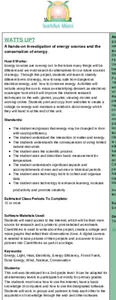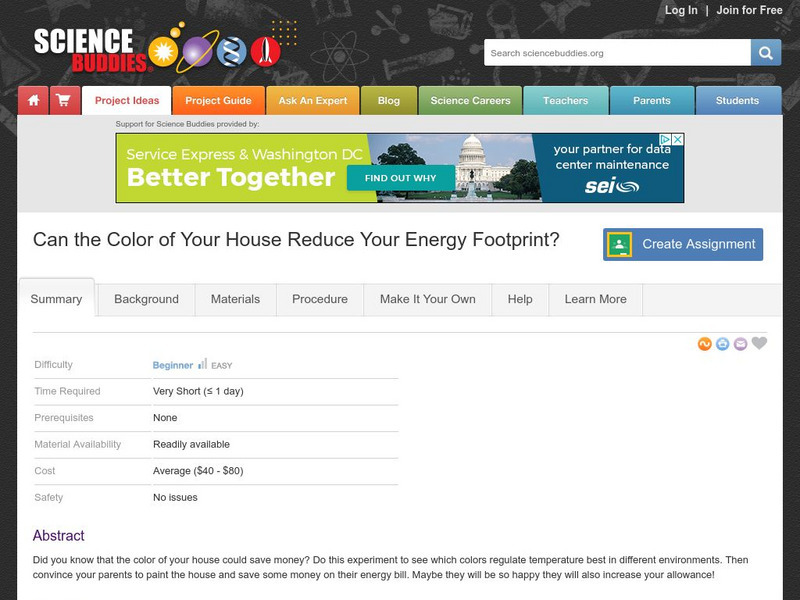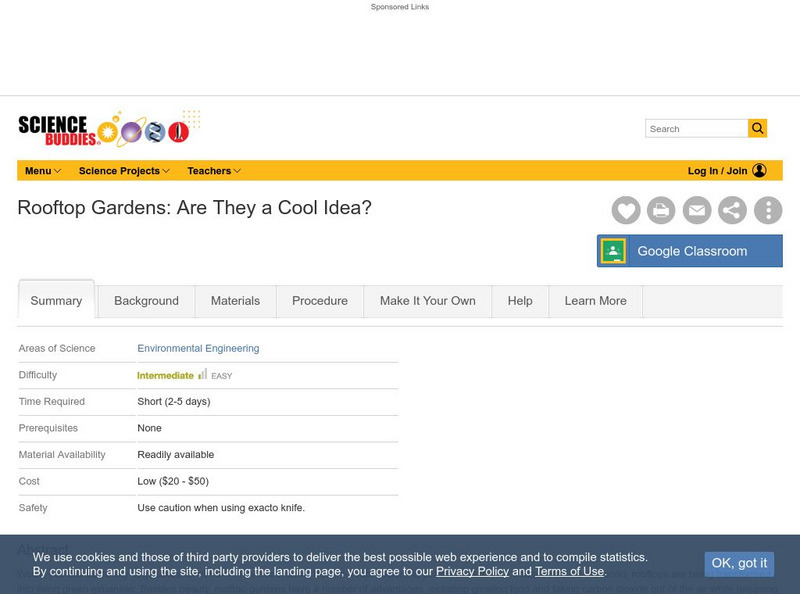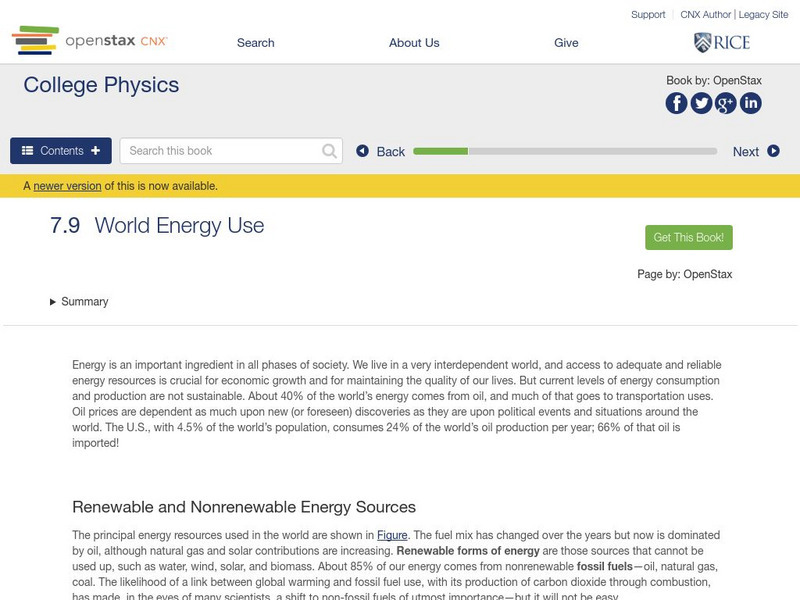Curated OER
Energy Efficiency Ambassadors
Students research and compare two products that provide the same function but require different amounts of energy to do the job. They examine and demonstrate energy efficiency and discover how it applies to different technologies and...
Curated OER
Energy for Free: Perpetual Motion Machines
Pupils observe the "drinking bird" perpetual motion machine and critically examine the designs of other so-called perpetual motion machines. They use this experience to create their own definition of conservation of energy.
Curated OER
Bouncing Basketballs
Students discover how the coefficient of restitution is applied to sports by measuring the bounciness of a ball. After examining the mathematical equation that applies to coefficient of restitution, students go to the gym, measure the...
Curated OER
Watt's Up
Young scholars analyze energy efficiency in lighting by visiting eight different classroom stations, determine cost vs. light output, graph their results, and answer questions on worksheet.
Curated OER
WATTS UP?
Second graders research the Internet as they classify different forms of energy, investigate electrical energy and how to conserve energy.
National Academies of Sciences, Engineering, and Medicine
The National Academies: Energy Efficiency
Reducing energy use is critically important to our future. This objective has been successfully met through many initiatives, such as improved appliance design, public education and streamlining procedures in industry. Some past...
eSchool Today
E School Today: Renewable Energy Sources
Learn what renewable energy is, the different types, and why it's important to conserve energy.
American Geosciences Institute
American Geosciences Institute: Energy
Seven hands-on lessons module where students learn about energy. These inquiry-based explorations investigate where energy resources come from and how they are converted into electricity, how fossil fuels form, the importance of...
National Academies of Sciences, Engineering, and Medicine
The National Academies: What You Need to Know About Energy
This very comprehensive site aims to provide the latest, most accurate information available about energy, its consumption, sources of energy, alternative energy, impact on the environment, and conservation. One section focuses on the...
Science Buddies
Science Buddies: Can the Color of Your House Reduce Your Energy Bill?
Did you know that the color of your house could save money? Do this experiment to see which colors regulate temperature best in different environments. Learn how painting the house can save money on the energy bill.
Science Buddies
Science Buddies: Rooftop Gardens: Are They a Cool Idea?
Around the world, rooftops are being transformed into living green expanses. Besides beauty, rooftop gardens have a number of advantages, including growing food and taking carbon dioxide out of the air while releasing breathable oxygen....
Science Buddies
Science Buddies: Spare a Watt, Save a Lot
In this science fair project, you will investigate the different uses of electricity in your home. By identifying appliances, and determining how much energy they use, as well as which are phantom loaders, you can determine if there are...
Science Buddies
Science Buddies: Green Your Pc: Help Your Computer Save Power
Check out this science fair project to determine how much power your PC really uses, and if it is an energy hog, how you can reduce its appetite for energy. You will learn how to profile and streamline your computer's power usage, while...
Climate Literacy
Clean: Compact Fluorescent Light Bulbs Cost Benefit Analysis
This analysis activity allows students to calculate electrical usage in home lighting, and create a cost-benefit analysis for cost and energy savings by replacement of incandescent light bulbs with compact fluorescent or LED light bulbs.
National Academies of Sciences, Engineering, and Medicine
The National Academies: Understanding Efficiency
This interactive activity from the The National Academies of Sciences examines the ways that improved energy efficiency can be achieved at home and on the road. Compare technology in both settings, and understand their energy...
Other
Canada Foundation for Innovation: Lofty Gardens
Dr. Jeremy Lundholm is a Halifax researcher who explores how plant-covered roof can save energy and make cities more livable. He promotes investing in green infrastructure as a way of cooling cities.
Other
Geothermal Education Office: Geothermal Energy
You will find an impressive amount of information including fact lists, definitions, and maps at this site. A great place to start a study of geothermal energy.
State Energy Conservation Office-Texas
State Energy Conservation Office: Energy Conservation in the Home [Pdf]
Looks at how energy is used in a home, and strategies in construction, choice of appliances, etc. for minimizing waste.
US Department of Energy
Us Dept. Of Energy: Urbita Elementary School: Linda Gregory: Draft O Meter [Pdf]
Students will observe drafts in homes and in the classroom to determine if or how much heat or air conditioning is escaping. How can the rooms be made more energy efficient?
National Geographic
National Geographic: Energy Solutions: Tapping Into Topography of Lake Turkana
In this lesson, students read and analyze articles about the alkaline water in Lake Turkana in Kenya, and about a wind energy project near Lake Turkana. They then examine the many factors that must be considered when undertaking this...
National Geographic
National Geographic: The Right Balance: Mixing Energy Resources
In this lesson, students look at profiles of energy production for different regions of the United States. They examine the conversion efficiency and the carbon dioxide emissions of each type of energy, and then the environmental impact...
US Department of Energy
U.s. Department of Energy: Energy Savers
Find information on everything from buying energy-efficient products to using the proper landscaping for particular climates to conserve resources. Starting with an energy assessment, this website will help users reduce their consumption...
OpenStax
Open Stax: World Energy Use
From a chapter on work and energy in a Physics textbook. This section of the chapter covers the difference between renewable and nonrenewable energy resources, the growth in the world's energy consumption, and the link between energy use...
TeachEngineering
Teach Engineering: Homes for Different Climates
Students learn about some of the different climate zones in China and consider what would be appropriate design, construction and materials for houses in those areas. This prepares them to conduct the associated activity(ies) in which...



















![State Energy Conservation Office: Energy Conservation in the Home [Pdf] Handout State Energy Conservation Office: Energy Conservation in the Home [Pdf] Handout](https://d15y2dacu3jp90.cloudfront.net/images/attachment_defaults/resource/large/FPO-knovation.png)



